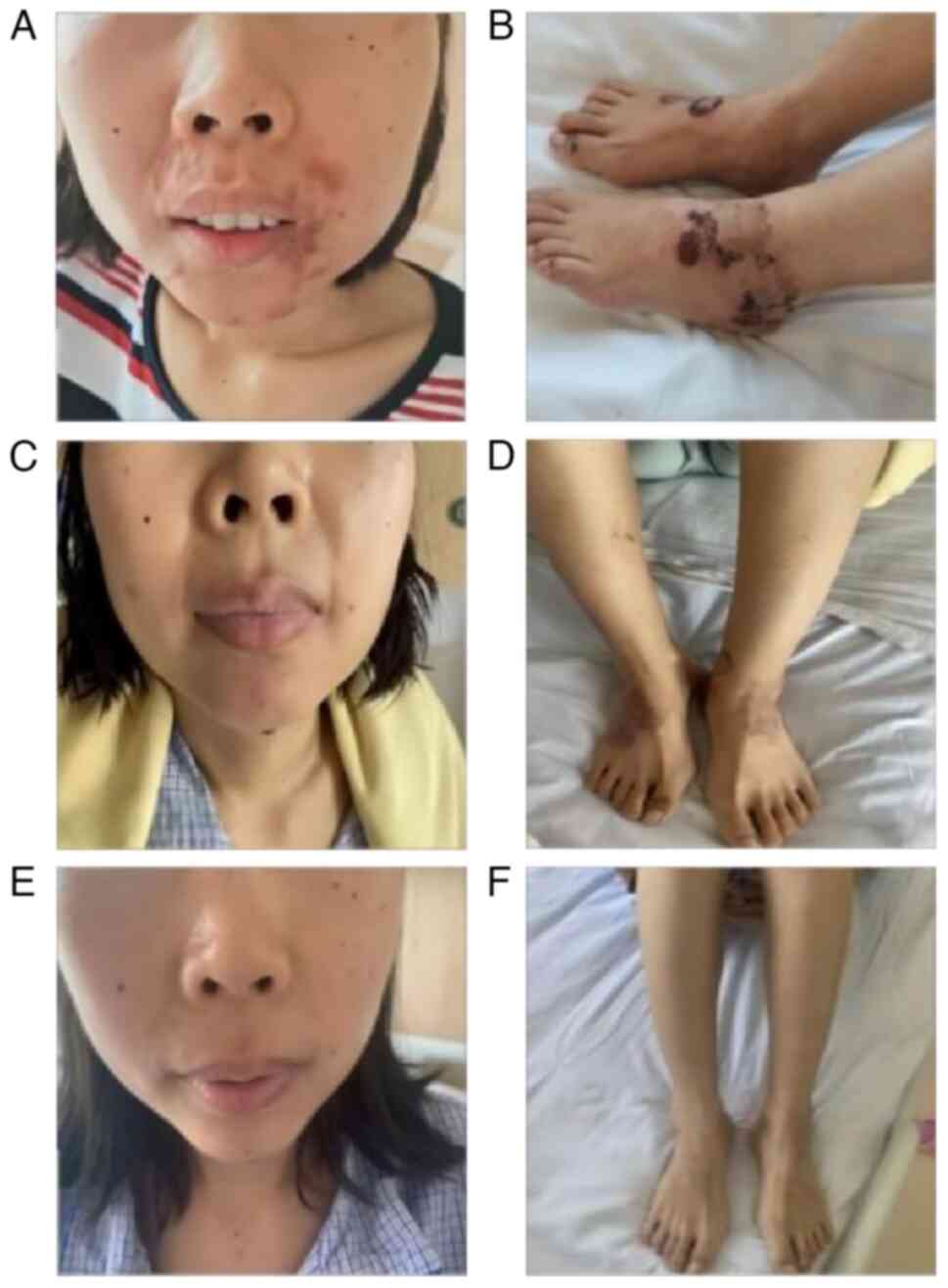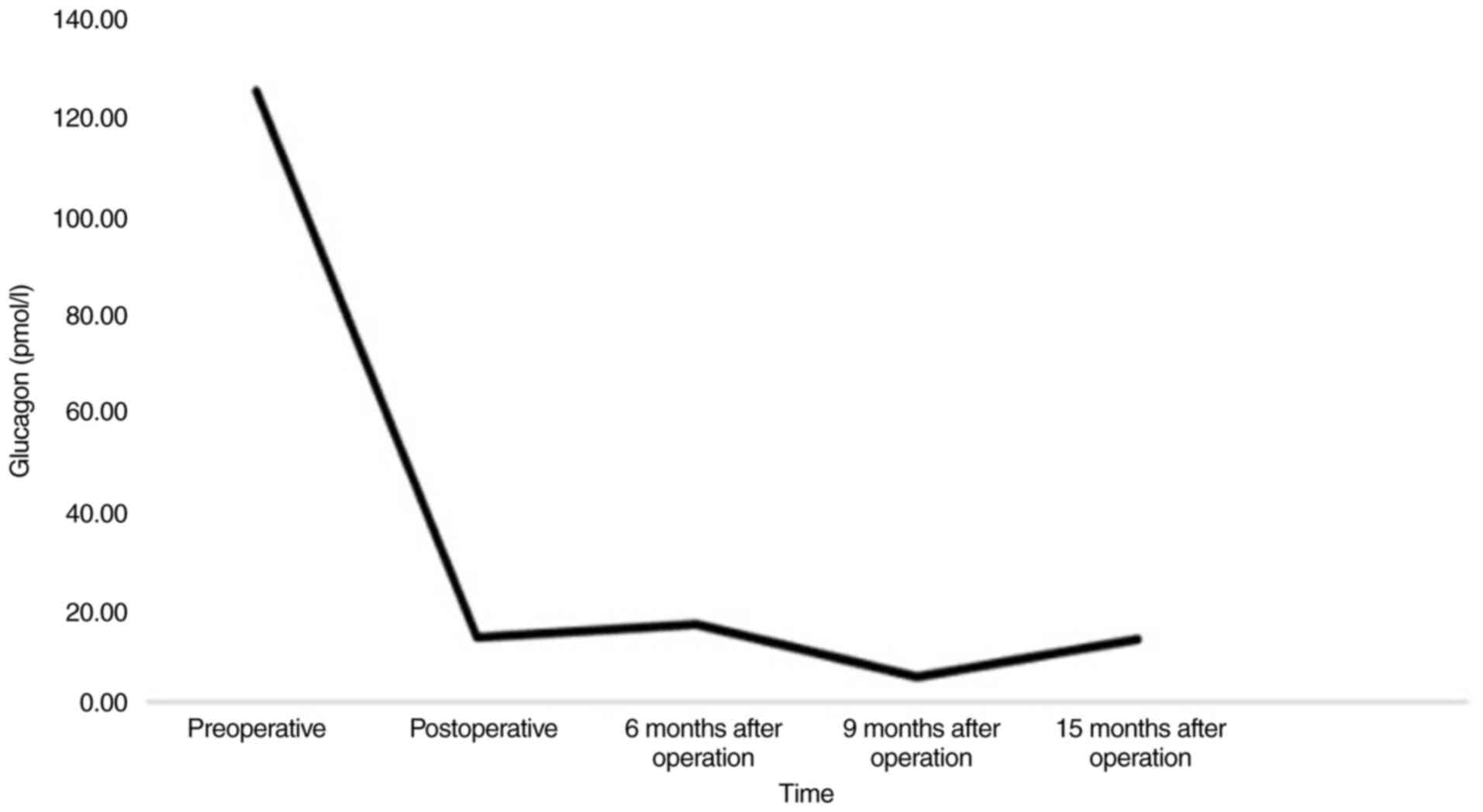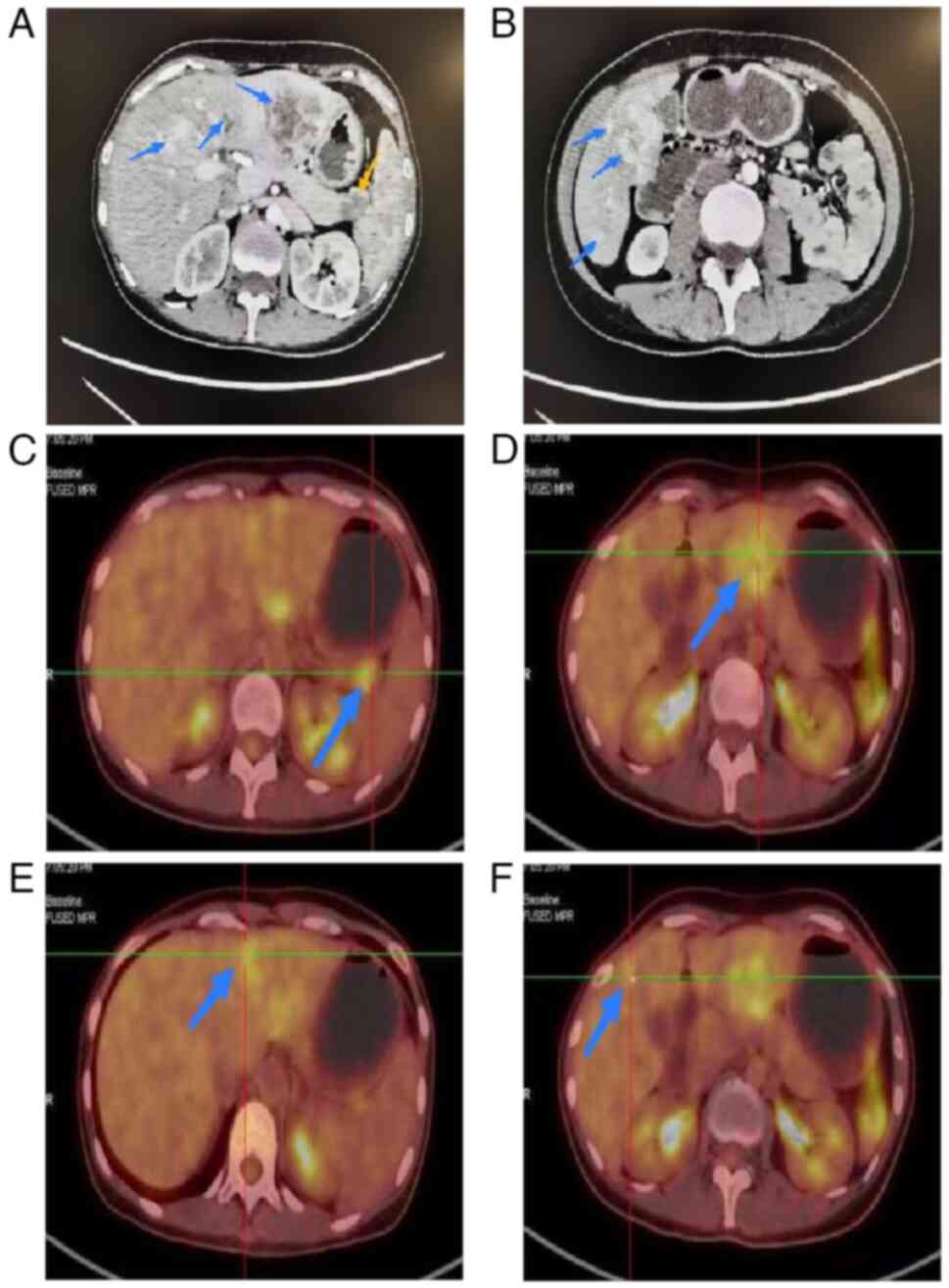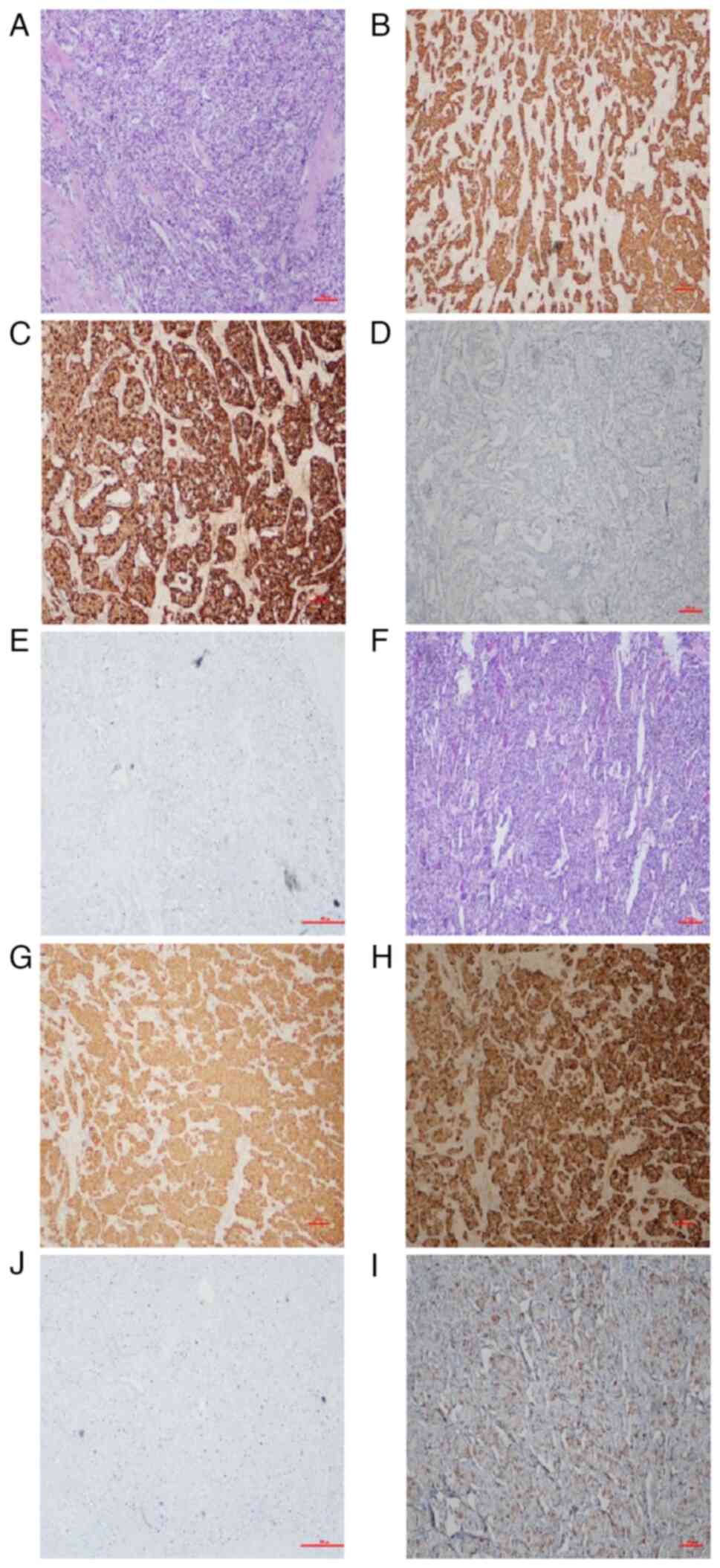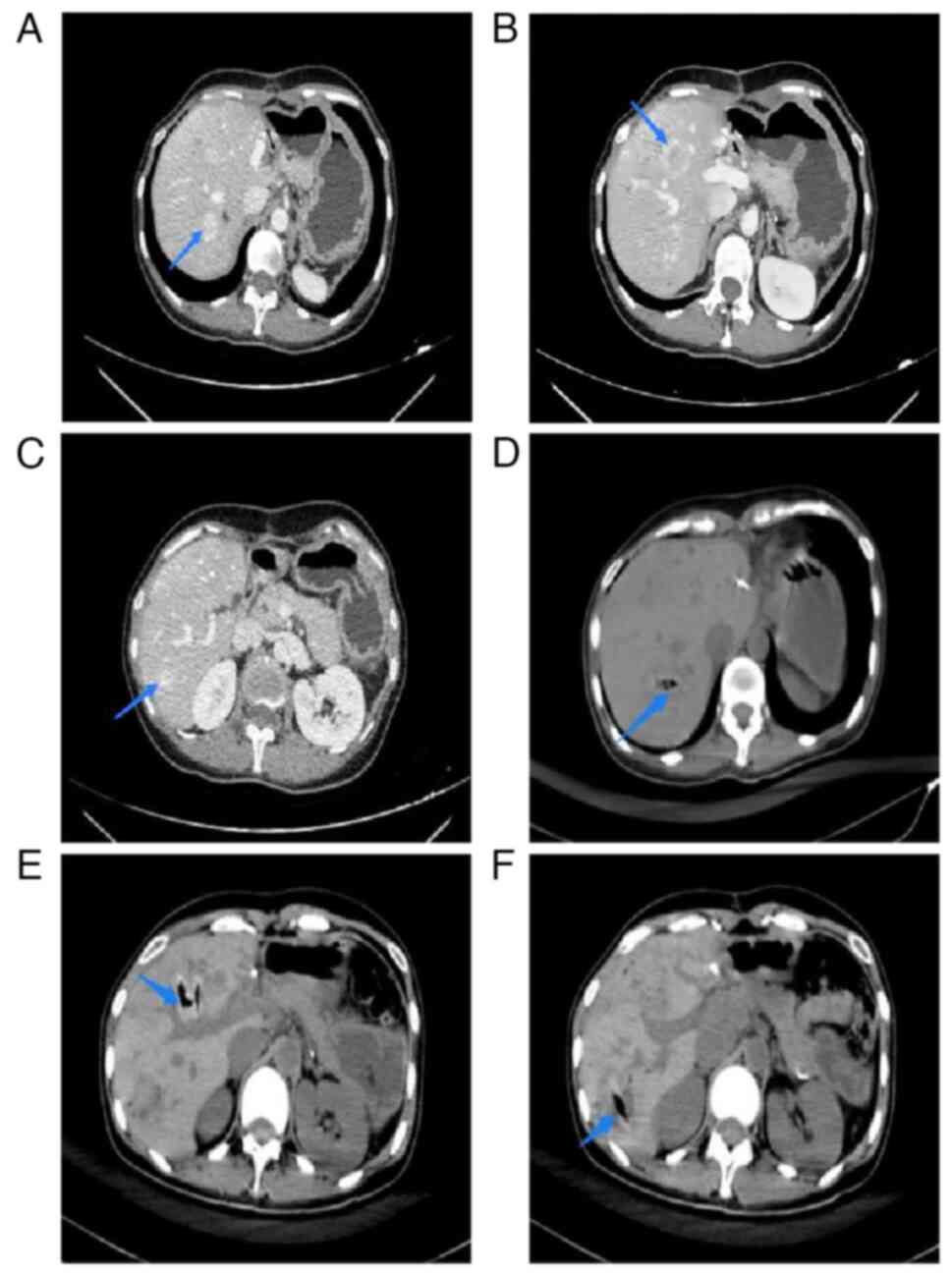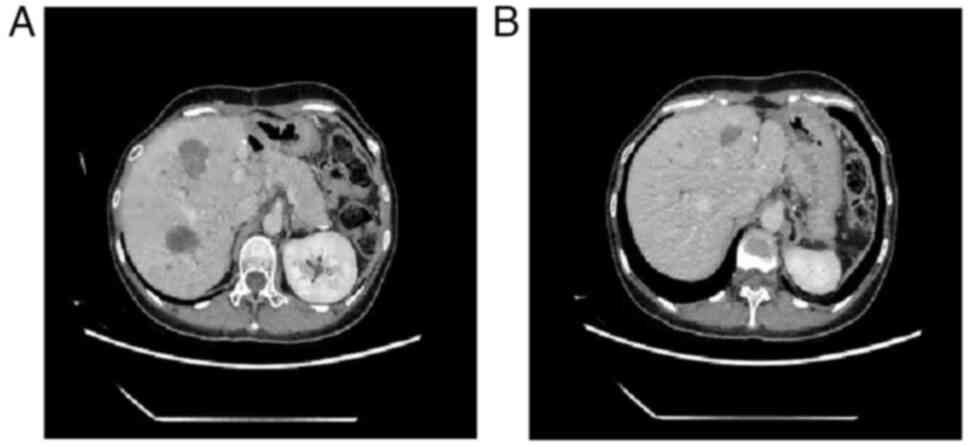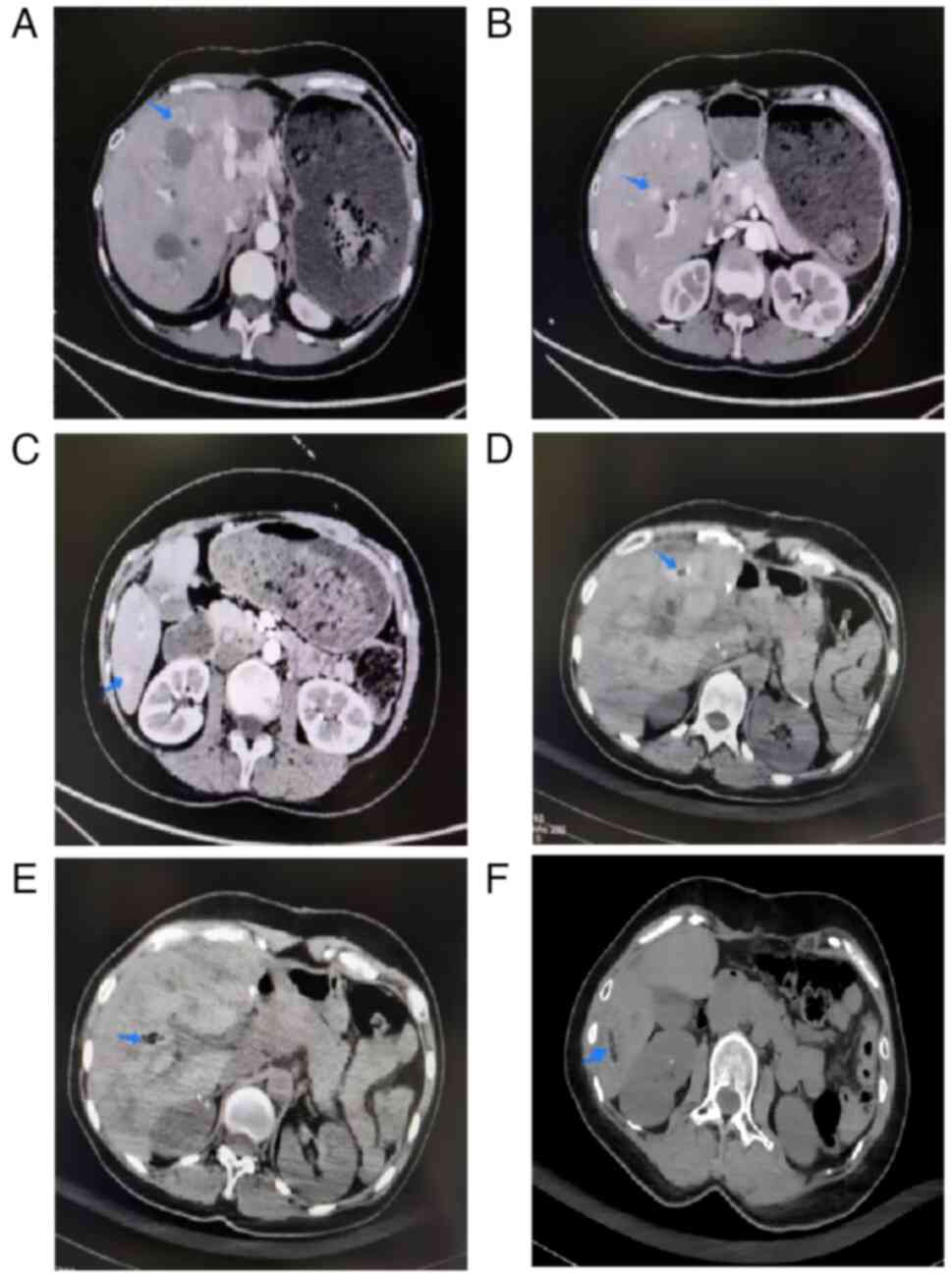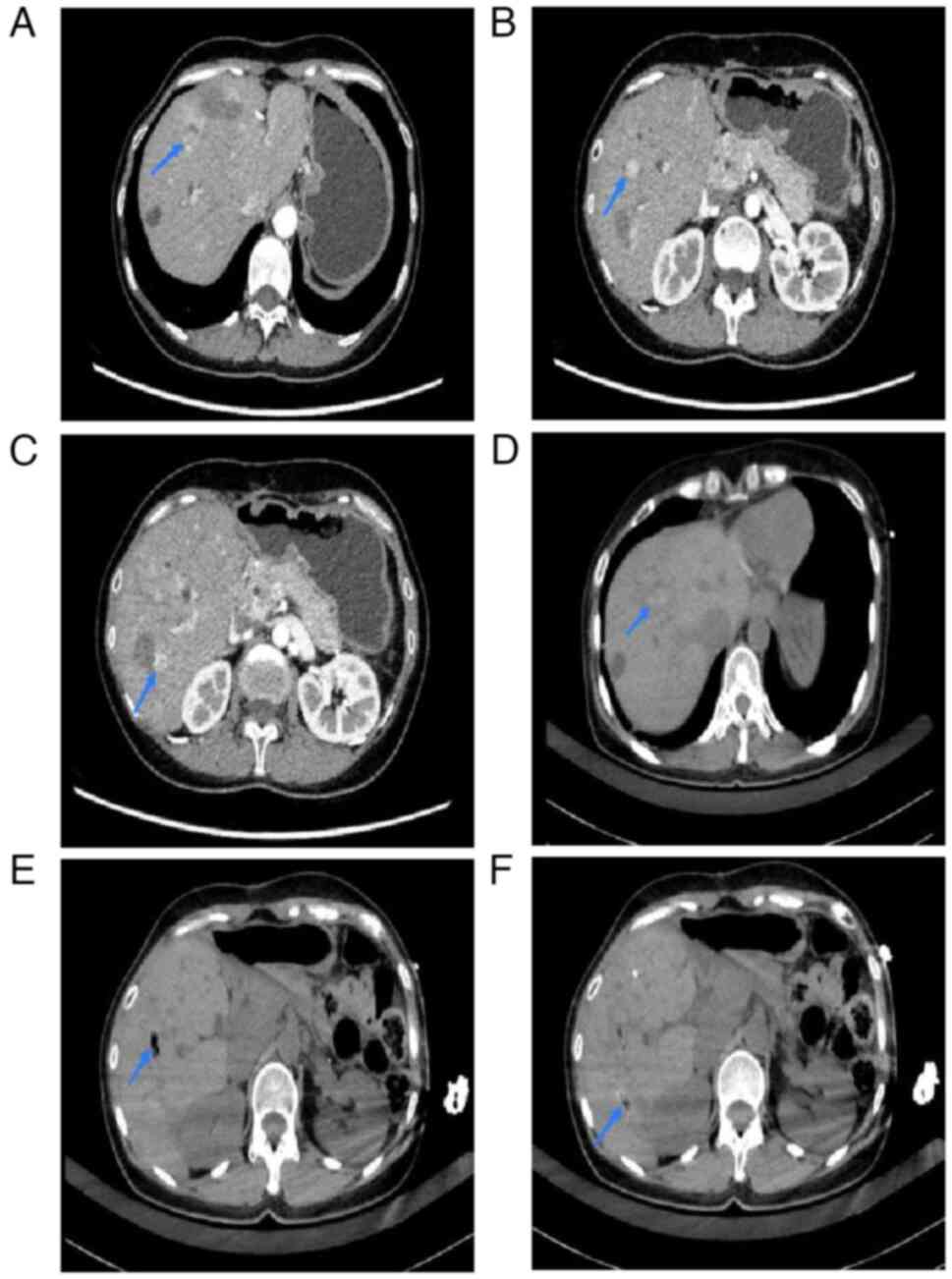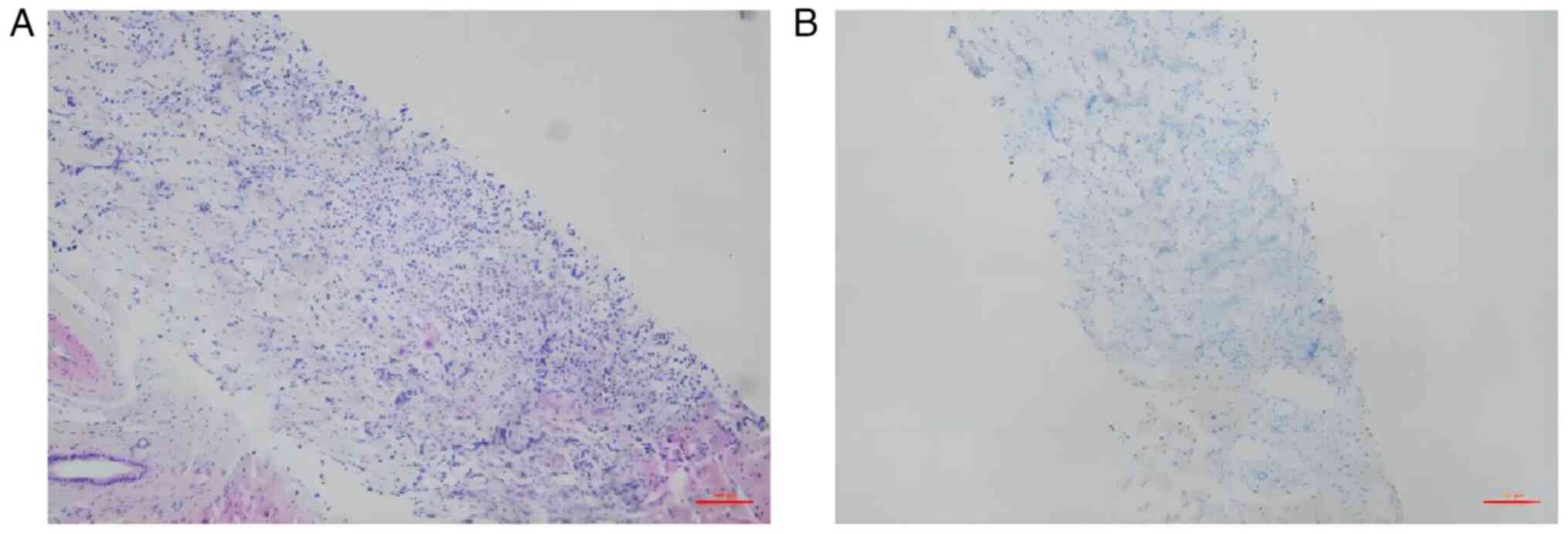Diagnosis and comprehensive treatment of a glucagonoma in a patient with residual intrahepatic metastases postoperatively: A case report and literature review
- Authors:
- Published online on: March 11, 2024 https://doi.org/10.3892/ol.2024.14336
- Article Number: 202
-
Copyright: © Yu et al. This is an open access article distributed under the terms of Creative Commons Attribution License.
Abstract
Introduction
Glucagonoma is a rare neuroendocrine tumor (NET) that arises from α-islet cells, representing 1% of all pancreatic NETs; its annual incidence worldwide is only ~1 per 20 million (1,2). Overproduction of glucagon, with necrolytic migratory erythema (NME), is the hallmark of glucagonoma and typically the first observed symptom. Other clinical findings include diabetes mellitus, anemia, weight loss, fat leakage and diarrhea (2,3). The clinical course may also be complicated by venous thrombosis, pulmonary embolism (30–50%) and various neuropsychiatric disorders, namely depression, psychosis, agitation, dementia, paranoid delusions, ataxia, hyperreflexia and optic atrophy (4,5). Despite a benign nature for some, the rate of malignant transformation is substantial (50–80%), with metastases generally present at the time of diagnosis (3,6). The liver and lymph nodes are the usual sites of spread (6).
Early and accurate diagnosis of glucagonoma may ensure proper management and improve the prognosis. Currently, surgical resection is the chief consideration (3), whereas the treatment of metastasis remains controversial. Thus far, available options [i.e., medical management, palliative surgery, chemotherapy, somatostatin analog (SSA) use and others] have yielded poor results in terms of overall survival and prognosis (7,8). A comprehensive and surgically oriented approach is perhaps the best means of optimizing long-term prognosis in instances of metastatic glucagonoma (9).
The present study reports the case of a 32-year-old female patient with glucagonoma, marked by multiple intrahepatic metastases and pathognomonic NME. The diagnostic and therapeutic challenges of managing initially advanced disease and later postoperative recurrences are also discussed.
Case report
Patient case
A 32-year-old female patient was hospitalized at the First Hospital of China Medical University (Shenyang, China) in September 2021, primarily for perioral dermatitis (Fig. 1A) and lower-limb NME (Fig. 1B) for a 2-month duration. Glossitis was also problematic for nearly 6 months. The patient had no family history of endocrine diseases, particularly diabetes. Laboratory testing indicated the following: i) mild anemia (Table I); ii) increases in neuron-specific enolase (NSE) and C-reactive protein (CRP) (Table I); and iii) oral glucose tolerance test (OGTT) abnormality (Table II). These findings signaled insulin resistance, despite a marginally low fasting blood glucose level. Plasma glucagon analysis indicated >10 times the upper limit of the normal range (124.00 pmol/l) (Fig. 2), and serum prolactin was elevated, but there was no imaging evidence of adenomas (parathyroid or pituitary) or other related pathology (Table I). On enhanced abdominal computed tomography (CT), a low-density defect of the pancreatic tail (~1.9×1.6 cm) and multiple low-density hepatic lesions (Fig. 3A and B) were visible. Positron emission tomography-CT confirmed increased metabolic activity at both pancreatic (Fig. 3C) [maximum standardized uptake value (SUVmax), 3.6] and intrahepatic sites (Fig. 3D-F) SUVmax, 4.5), while excluding involvement elsewhere. The aforementioned features were interpreted as a glucagonoma, with multiple intrahepatic metastases.
Hepatic spread ordinarily would preclude a complete resection. However, the patient's liver was functionally intact (Table I), the patient was young and in otherwise good health, and no invasion of the main artery was evident. Consequently, a distal pancreatectomy and splenectomy (DPS), with palliative resections of the hepatic metastases, was performed. Tissue examination thereafter confirmed a primary pancreatic neuroendocrine tumor [grade 2 (1)] (Fig. 4A-E), metastatic to the liver (Fig. 4F-J). Both primary and metastatic lesions proved immunohistochemically positive for glucagon [pancreas, 40%+ (Fig. 4D); liver, 90%+ (Fig. 4I)], synaptophysin (Syn) (Fig. 4B and F) and chromogranin A (CgA) (Fig. 4C and H). The Ki-67 indices were 15% each (Fig. 4E and J).
After surgery, the patient was administered periodic intramuscular injections (every 28 days) of a long-acting release (LAR) octreotide (30 mg) formulation as long-term therapy (a total of 18 times to date). The erythema of both lower limbs (Fig. 1C and D) resolved by postoperative day 7, as did the oral manifestations. The serum glucagon level also normalized (13.34 pmol/l) (Fig. 2), in sharp contrast with the preoperative baseline. However, multiple low-density hepatic lesions reappeared on the 6-month follow-up CT scans. Initially, CT-guided microwave ablation (tumor in right anterior lobe of liver: 50 W for 8 min; tumor in right posterior lobe of liver: 60 W for 10 min) was performed, with post-treatment CT imaging (Before: Fig. 5A-C; after: Fig. 5D-F). CT imaging at the patient review performed at 10 months postoperatively showed that the liver lesions were smaller than before (Fig. 6A and B). CT-guided microwave ablation (tumor in right anterior lobe of liver: 70 W for 5 min; tumor in right posterior lobe of liver: 60 W for 8 min; tumor in left medial lobe: 60 W for 5 min) was also undertaken at 18 months postoperatively (before: Fig. 7A-C; after: Fig. 7D-F) and ablation (lower end of right lobe, top end of diaphragm and right anterior lobe of liver: 60 W for 8 min each) was performed at 24 months postoperatively (before: Fig. 8A-C; after: Fig. 8D-F), targeting all tumor recurrences. A percutaneous needle biopsy obtained prior to ablation disclosed tumor angiogenesis; but the residual neuroendocrine tumor (grade 2) was no longer positive for glucagon (Fig. 9), and serum glucagon levels had stabilized, falling within the normal range (5.35 pmol/l) (Fig. 2). To date, intramuscular administration of LAR octreotide has continued every 28 days at the same dose, without complications or adverse reactions. The patient was treated every 28 days and followed up at the same time. The last visit was in mid-January 2024. There was no evidence of local or systemic recurrence.
Pathology
Hematoxylin and eosing stainingTissues was fixed with 10% neutral formalin at room temperature for 16–18 h, and then cut into 4-µm thickness. The sections were dewaxed at 45°C for ~5 min. The sections were stained with hematoxylin and eosin at room temperature for 3.75 min using the Roche Ventana HE 600 automatic staining system (Roche Diagnostics), and then sealed with neutral gum. The staining was evaluated under a light microscope at ×100 magnification.
Immunohistochemical staining
The sections were dewaxed at 45°C for ~5 min, and then repaired with immunohistochemical antigen repair solution (neutral) at 99°C for 20 min. The antibodies (immediate-use Syn antibody reagent; cat. no. 20180177; immediate-use CgA antibody reagent; cat. no. 20180186; immediate-use glucagon antibody reagent; cat. no. 20180317; immediate-use Ki-67 antibody reagent; cat. no. 20180160) (all Fuzhou Maixin Biotech Co., Ltd.) were separately added to the BenchMark XT on the Roche Ventana platform at 32°C for 30 min. After washing with PBS, DAB staining was performed at 36°C using 25 ml ultraView Universal DAB Inhibitor (3% H2O2) for 8 min, 25 ml ultraView Universal HRP Multimer (55 µg/ml) for 8 min, 25 ml ultraView Universal DAB Chromogen (0.2% w/v DAB) plus 25 ml ultraView Universal DAB H2O2 (0.04% H2O2) for a total of 8 min, and 25 ml ultraView Universal DAB Copper (5 g/l CuSO4) for 4 min. Washing with PBS was performed between each step. The sections were then mounted. Evaluation of staining was performed under a light microscope at ×100 magnification.
Discussion
Glucagonomas are particularly rare neuroendocrine neoplasms (5,10). The neoplasms manifest clinically as glucagonoma syndrome, the hallmark of which is NME (10,11). Most of those previously reported had spread to the liver or lymph nodes and were overtly malignant, underscoring the importance of prompt detection (12,13). The patient treated in the present study was hospitalized primarily for NME, so it is apparent that clinical factors figure prominently in diagnostic accuracy (10,14). However, such determinations are not without difficulties. Most patients are diagnosed with diabetes or skin disease and the real lesion is missed (15,16). In our experience, a combination of clinical and laboratory findings works best, applying present-day diagnostic criteria for glucagonoma as follows: i) Elevated serum glucagon level by radioimmunoassay; ii) radiographic or histological evidence of a neuroendocrine tumor; and iii) characteristic clinical features (NME) (10,13,17). The relapse of NME is therefore a pivotal and telling development. In addition, the patients with pancreatic glucagonomas sometimes exhibit complications of pituitary and parathyroid tumors (13,15,16). In the present case, although the enhanced abdominal CT scan of the patient showed the pancreatic glucagonoma to be hypervascular, the case was not complicated by pituitary and parathyroid tumors.
Although benign on occasion, glucagonomas are often malignant and possibly have already disseminated at the time of discovery. The long-term prognosis is subsequently poor, despite an array of available therapeutic options (7,8). Conventional or laparoscopic resection is safe and effective, associated with low rates of recurrence; however, only 10–20% of patients are surgically curable, given the propensity for multicentric tumor dissemination (18). Ultimately, the benefits of surgery must be weighed against potential complications and mortality risks (19–21). In instances of liver metastasis, a surgical solution remains controversial, given the protracted and unpredictable course of glucagonomas. For the most part, surgical resection is still the mainstay of treatment for localized disease, whereas palliative cytoreductive surgery may help relieve symptoms and effectively confer prognostic improvement. Even with known metastasis, resecting the primary tumor prolongs patient survival (21,22).
Hormonal secretion by functional glucagonomas is most often suppressed through SSA use. These first-line agents for symptom control also exert certain anti-proliferative tumor effects, thus prolonging disease-free survival in some patients (23,24). While undergoing systemic treatment, patients with liver metastases <5 cm maximally (preferably <3 cm) may qualify for ablative treatments as well (25,26). Ablative interventions seem to boost symptom relief in this setting (lasting 14–27 months) and have generated 5-year survival rates of 57–80% (27).
The present patient harbored multiple metastases upon presentation. However, a younger age and favorable preoperative status permitted a DPS procedure, with palliative resections of existing hepatic nodules. Afterwards, the patchy changes to the facial and lower-leg skin gradually resolved. Serum glucagon levels were also monitored at intervals and marked improvement was found postoperatively. After 6 months, several hepatic lesions were again discovered, and the larger growths were subjected to percutaneous ablation. For the treatment of postoperative liver metastases in this patient, ablation therapy was more desirable than transarterial therapy (25,27). The patient continued to receive intramuscular injections of LAR octreotide (30 mg) while undergoing three separate ablative procedures. All existing hepatic disease was successfully eradicated as a result. Nonetheless, continued monitoring of serum glucagon and imaging parameters is obligatory.
To date, the patient's symptoms are gone, and the postoperative glucagon levels have normalized, aligning with the results of repeat immunostaining of glucagon expression in a liver biopsy specimen. This indicates that the patient with multiple intrahepatic metastases may benefit from palliative surgery, conducting postoperative ablative treatments as needed during SSA administration. The prognosis corresponds well with tumor classification, grading and disease stage. The 5-year overall survival rate is ~54%, and the 5-year relative survival rates of localized, locally advanced and metastatic glucagonoma are 93, 77 and 27%, respectively (27,28). Although the expected survival time in instances of metastatic glucagonoma is ~20 months (28), the clinical course of the present patient indicates that prolongation is feasible, given a prompt diagnosis and optimal therapeutic choices.
In the event of multiple liver metastases, palliative metastasectomies and postoperative ablations may be beneficial and help prolong survival time, while achieving hormone-related symptoms control through SSA use (29–32). In the present study, the LAR formulation of octreotide was found to be an important and effective long-term therapy, although its merit may be debated due to the scarcity of data.
In conclusion, in patients with glucagonomas, the comprehensive treatment of advanced disease is a complex process, guided by overall patient fitness and tumor characteristics. A multimodal effort would be ideal, gathering as many patients as possible for analysis and exploring the full scope of individualized therapy. Managing these neoplastic oddities may then become more systematic and uniform to optimize patient outcomes.
Acknowledgements
The authors would like to thank Professor Chunlin Ge (Department of Hepatobiliary and Pancreatic Surgery, The First Hospital of China Medical University, Shenyang, China) for performing the surgical resections, Professor Yonghui Xia (Department of Interventional Radiology, The First Hospital of China Medical University) for performing the percutaneous ablative procedures, Professor Jin Wang (Department of Medical Oncology, The First Hospital of China Medical University) for providing the postoperative therapeutics and Dr Hongjiu Ren (Department of Clinical Pathology, The First Hospital of China Medical University) for providing the pathology-related data.
Funding
This study was funded by the Youth Talent Support Program of China Medical University (grant no. QGZD2018014).
Availability of data and materials
The data generated in the present study are included in the figures and/or tables of this article.
Authors' contributions
SY and MG communicated with various departments, collected patient information, and carried out clinical management and prognostic follow-up. CZ was responsible for obtaining medical images and analyzing data related to patient laboratory tests and imaging findings. LC provided and analyzed disease-related diagnostic and treatment information. LZ was responsible for the treatment of the patient, the preoperative clinical management, the formulation of treatment plans, the completion of the operation with Professor Chunlin Ge, and the comprehensive treatment in the perioperative period. SY and LZ confirm the authenticity of all the raw data. All authors have read and approved the final manuscript.
Ethics approval and consent to participate
The patient provided written informed consent to participate.
Patient consent for publication
The patient provided written informed consent for publication of this report and the attached images.
Competing interests
The authors declare that they have no competing interests.
References
|
Nagtegaal ID, Odze RD, Klimstra D, Paradis V, Rugge M, Schirmacher P, Washington KM, Carneiro F and Cree IA; WHO Classification of Tumours Editorial Board, : The 2019 WHO classification of tumours of the digestive system. Histopathology. 76:182–188. 2020. View Article : Google Scholar : PubMed/NCBI | |
|
Schwartz RA: Glucagonoma and pseudoglucagonoma syndromes. Int J Dermatol. 36:81–89. 1997. View Article : Google Scholar : PubMed/NCBI | |
|
Stacpoole PW: The glucagonoma syndrome: Clinical features, diagnosis, and treatment. Endocr Rev. 2:347–361. 1981. View Article : Google Scholar : PubMed/NCBI | |
|
Yusuf MA, Mehmood S, Iftikhar J, Saqib M, Siddique MZ and Imtiaz W: Glucagonoma syndrome: A Rare paraneoplastic disorder due to neuroendocrine tumor of the pancreas. J Coll Physicians Surg Pak. 32 (Suppl):S147–S149. 2022. View Article : Google Scholar : PubMed/NCBI | |
|
Eldor R, Glaser B, Fraenkel M, Doviner V, Salmon A and Gross DJ: Glucagonoma and the glucagonoma syndrome-cumulative experience with an elusive endocrine tumour. Clin Endocrinol (Oxf). 74:593–598. 2011. View Article : Google Scholar : PubMed/NCBI | |
|
Metz DC and Jensen RT: Gastrointestinal neuroendocrine tumors: Pancreatic endocrine tumors. Gastroenterology. 135:1469–1492. 2008. View Article : Google Scholar : PubMed/NCBI | |
|
Toberer F, Hartschuh W and Wiedemeyer K: Glucagonoma-Associated necrolytic migratory erythema: The broad spectrum of the clinical and histopathological findings and clues to the diagnosis. Am J Dermatopathol. 41:e29–e32. 2019. View Article : Google Scholar : PubMed/NCBI | |
|
Li W, Yang X, Deng Y, Jiang Y, Xu G, Li E, Wu Y, Ren J, Ma Z, Dong S, et al: Necrolytic migratory erythema is an important visual cutaneous clue of glucagonoma. Sci Rep. 12:90532022. View Article : Google Scholar : PubMed/NCBI | |
|
Doi R: Surgical management of pancreatic endocrine tumors. Nihon Rinsho. 69 (Suppl 2):S611–S666, (In Japanese). | |
|
John AM and Schwartz RA: Glucagonoma syndrome: A review and update on treatment. J Eur Acad Dermatol Venereol. 30:2016–2022. 2016. View Article : Google Scholar : PubMed/NCBI | |
|
Cui M, Wang R and Liao Q: Necrolytic migratory erythema: An important sign of glucagonoma. Postgrad Med J. 97:1992021. View Article : Google Scholar : PubMed/NCBI | |
|
Wermers RA, Fatourechi V, Wynne AG, Kvols LK and Lloyd RV: The glucagonoma syndrome. Clinical and pathologic features in 21 patients. Medicine (Baltimore). 75:53–63. 1996. View Article : Google Scholar : PubMed/NCBI | |
|
Chastain MA: The glucagonoma syndrome: A review of its features and discussion of new perspectives. Am J Med Sci. 321:306–320. 2001. View Article : Google Scholar : PubMed/NCBI | |
|
Tolliver S, Graham J and Kaffenberger BH: A review of cutaneous manifestations within glucagonoma syndrome: Necrolytic migratory erythema. Int J Dermatol. 57:642–645. 2018. View Article : Google Scholar : PubMed/NCBI | |
|
Song X, Zheng S, Yang G, Xiong G, Cao Z, Feng M, Zhang T and Zhao Y: Glucagonoma and the glucagonoma syndrome. Oncol Lett. 15:2749–2755. 2018.PubMed/NCBI | |
|
He S, Zeng W, Geng S and Jia J: Glucagonoma syndrome with atypical necrolytic migratory erythema. Indian J Dermatol Venereol Leprol. 87:49–53. 2021. View Article : Google Scholar : PubMed/NCBI | |
|
Wang ZX, Wang F and Zhao JG: Glucagonoma syndrome with severe erythematous rash: A rare case report. Medicine (Baltimore). 98:e171582019. View Article : Google Scholar : PubMed/NCBI | |
|
Sarmiento JM and Que FG: Hepatic surgery for metastases from neuroendocrine tumors. Surg Oncol Clin N Am. 12:231–242. 2003. View Article : Google Scholar : PubMed/NCBI | |
|
Madoff DC, Gupta S, Ahrar K, Murthy R and Yao JC: Update on the management of neuroendocrine hepatic metastases. J Vasc Interv Radiol. 17:1235–1250. 2006. View Article : Google Scholar : PubMed/NCBI | |
|
Ito T, Igarashi H and Jensen RT: Therapy of metastatic pancreatic neuroendocrine tumors (pNETs): Recent insights and advances. J Gastroenterol. 47:941–960. 2012. View Article : Google Scholar : PubMed/NCBI | |
|
Saeed A, Buell JF and Kandil E: Surgical treatment of liver metastases in patients with neuroendocrine tumors. Ann Transl Med. 1:62013.PubMed/NCBI | |
|
Vaghaiwalla T and Keutgen XM: Surgical management of pancreatic neuroendocrine tumors. Surg Oncol Clin N Am. 29:243–252. 2020. View Article : Google Scholar : PubMed/NCBI | |
|
Kvols LK, Moertel CG, O'Connell MJ, Schutt AJ, Rubin J and Hahn RG: Treatment of the malignant carcinoid syndrome. Evaluation of a long-acting somatostatin analogue. N Engl J Med. 315:663–666. 1986. View Article : Google Scholar : PubMed/NCBI | |
|
Ruszniewski P, Ish-Shalom S, Wymenga M, O'Toole D, Arnold R, Tomassetti P, Bax N, Caplin M, Eriksson B, Glaser B, et al: Rapid and sustained relief from the symptoms of carcinoid syndrome: Results from an open 6-month study of the 28-day prolonged-release formulation of lanreotide. Neuroendocrinology. 80:244–251. 2004. View Article : Google Scholar : PubMed/NCBI | |
|
Farley HA and Pommier RF: Treatment of neuroendocrine liver metastases. Surg Oncol Clin N Am. 25:217–225. 2016. View Article : Google Scholar : PubMed/NCBI | |
|
Kose E, Kahramangil B, Aydin H, Donmez M, Takahashi H, Aucejo F, Siperstein A and Berber E: Outcomes of laparoscopic tumor ablation for neuroendocrine liver metastases: A 20-year experience. Surg Endosc. 34:249–256. 2020. View Article : Google Scholar : PubMed/NCBI | |
|
Mohan H, Nicholson P, Winter DC, O'Shea D, O'Toole D, Geoghegan J, Maguire D, Hoti E, Traynor O and Cantwell CP: Radiofrequency ablation for neuroendocrine liver metastases: A systematic review. J Vasc Interv Radiol. 26:935–942.e1. 2015. View Article : Google Scholar : PubMed/NCBI | |
|
Dasari A, Shen C, Halperin D, Zhao B, Zhou S, Xu Y, Shih T and Yao JC: Trends in the incidence, prevalence, and survival outcomes in patients with neuroendocrine tumors in the United States. JAMA Oncol. 3:1335–1342. 2017. View Article : Google Scholar : PubMed/NCBI | |
|
Chan JA and Kulke MH: Medical management of pancreatic neuroendocrine tumors: Current and future therapy. Surg Oncol Clin N Am. 25:423–437. 2016. View Article : Google Scholar : PubMed/NCBI | |
|
Saltz L, Trochanowski B, Buckley M, Heffernan B, Niedzwiecki D, Tao Y and Kelsen D: Octreotide as an antineoplastic agent in the treatment of functional and nonfunctional neuroendocrine tumors. Cancer. 72:244–248. 1993. View Article : Google Scholar : PubMed/NCBI | |
|
Lo CH, Ho CL and Shih YL: Glucagonoma with necrolytic migratory erythema exhibiting responsiveness to subcutaneous octreotide injections. QJM. 107:157–158. 2014. View Article : Google Scholar : PubMed/NCBI | |
|
Kimbara S, Fujiwara Y, Toyoda M, Chayahara N, Imamura Y, Kiyota N, Mukohara T, Fukunaga A, Oka M, Nishigori C and Minami H: Rapid improvement of glucagonoma-related necrolytic migratory erythema with octreotide. Clin J Gastroenterol. 7:255–259. 2014. View Article : Google Scholar : PubMed/NCBI |



